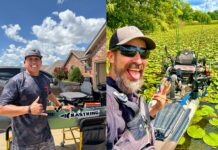 How did you become a photographer?
How did you become a photographer?
I was always the kid with the camera. When I was in high school, I saved my money and bought an SLR film camera. The camera didn’t have automatic exposure and shutter speed, so I had to learn the hard way.
As a lifelong outdoorsman, I would bring my camera hunting and fishing. Capturing my adventures was the best way to remember places and experiences the way I saw them.
My freshman year of college, my parents gave me a DSLR. My first client was a mountain bike magazine. I continued to work on my skills and combine photography with outdoor adventures.
Recently, I’ve been working with marketing teams encouraging me to bring an artistic edge to advertising photography.
What was your toughest shoot?
Combine outdoors with electronics and things are bound to go wrong. One time I was flying my drone through dense mist in freezing temperatures to get an overhead shot of a lake.
The light produced sharp contrast between the snowy trees and black water. The mist was heavier than I realized, freezing on the propellers. I started to lose control. Undeterred, I flew higher above the mist and got the shot.
On the return, one motor died, crippling the steering and causing the drone to crash into the forest. Using the last GPS location, I was able to dig the drone out of a foot of snow. I saved the shot. After the drone dried out, I replaced the propellers and it still works.
What is your favorite location?
Most of my photography occurs in the wilds of Maine. Last year, I was invited to shoot Vibe Kayaks in Tallahassee, Florida.
Our guide, Harry Smith, took us to a spot I can’t get out of my mind: the Wacissa River. The water is crystal clear, filled with grass, cypress trees draped in Spanish moss line the banks.
The place is quiet and dramatic, great for photos.
Why kayak fishing?
After a lifetime in the outdoors, kayaking was a natural progression; there’s no better way to access the backcountry and carry all my gear. Kayaking is quiet, so I don’t spook wildlife.
I feel connected to nature. And I’ve had some great fishing. I’m most proud of catching a seven-pound smallmouth. After fishing hard all day with little to show, I kept grinding away cast after cast.
My persistence paid off when I hooked the trophy fish. Not only was it my personal best, but I got great photos.

Share your best photography hack.
I hate to give away secrets. Everyone knows a tripod produces the sharpest photos. Don’t be afraid to get the tripod wet. I’ll sink my tripod to the ball head for a unique perspective. Using a remote shutter release allows me to take high-quality selfies.
What’s your favorite camera gear?
My kayak fishing set-up is a Sony A6000 and 50mm f1.8 lens. I use a dive housing to get over/under photos. My lightweight drone is a DJI Spark. This is entry-level gear, but I get high-quality photos and I don’t cry if I lose my stuff to the water.
Give advice to amateur photographers.
Shooting in RAW format is the first step in learning to process your images without tacking on a ton of filters. The goal of natural photographs is to perfectly replicate what the human eye sees. To pull it off, control exposure, aperture and ISO before taking the shot.
This is his day job. Photo: Matt Charette

 How did you become a photographer?
How did you become a photographer?




